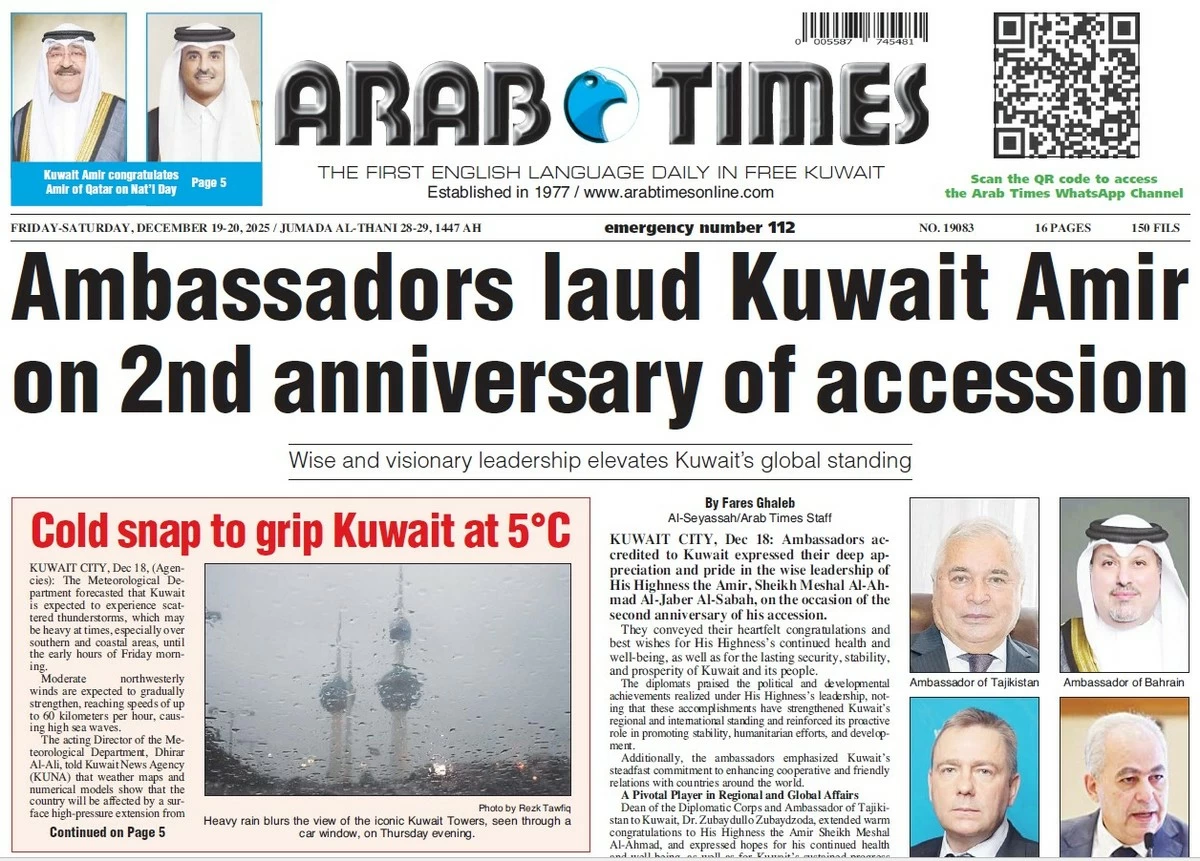19/12/2015
19/12/2015
KUWAIT CITY, Dec 18: With its December first tightening in 9 years, the so-called “lift-off” is finally behind us. Phew! The federal funds rate is up 25 basis points (bps) to a target of 25- 50 bps. Markets can now move on to the next set of questions: how much and how fast for the Fed? What of the impact on the US economy, EMs, commodities, currencies etc? The GCC countries were quick to follow suit; Kuwait, the UAE, Bahrain and KSA all raised policy rates immediately following the Fed, by 25 bps each.
Analysts and markets are for the most part expecting a ho-hum 2016 for economies, slightly better than 2014 and 2015 when world growth averaged 3.2 percent. The IMF is looking for world GDP growth of 3.6 percent, “OK” growth but nothing very spectacular; especially with China growth slowing, the risk is for a downward revision back toward the pace of 2014-15. For the large economies, the US is expected to grow 2.8 percent, the Euro area 1.6 percent, Japan 1.0 percent, China 6.3 percent and EMs at large 4.5 percent. In our view, the US and emerging markets are more prone to later downward revisions.
Under this scenario, the markets expect the Fed to target a fed funds rate of 75-100 bps in December 2016, all the while the Fed is “signaling” it expects that rate closer to 150 bps. The latter does seem excessive and time and data may well change things and expectations in 2016. On a related matter, the ECB recently disappointed markets by “only” cutting its deposit rates and extending its current QE program, from September 2016 to March 2017. It failed however to meet market expectations of an increase in its monthly purchases of securities (currently EUR 60 billion). That ECB announcement, in December, prompted a large and swift correction in the euro/USD rate by close to 5 percent.
Market participants have since been reassessing the “easy” call that had the policy divergence between the ECB and the Fed causing a continuation of the recent one-way dollar rally. This reassessment will be compounded by lower oil prices that will weigh on inflation/deflation and keep real interest rates higher than otherwise in the Eurozone. In light of the less dramatic central bank “divergence”, analysts have revised their views on the dollar, with a small minority of dollar bears, and many dollar bulls revising down their dollar targets. Another market disappointment came from the December OPEC meeting.
OPEC kept its guidance quota unchanged at 30 million barrels per day (b/d) (current production is above that, near 31.5 million b/d), with Iran still poised to hike production ahead. Dashed hopes of a production cut sent oil prices tumbling toward 9-year lows. Lower oil prices have occasionally pressured equities and not just in the GCC oil sensitive economies. Equities in the advanced economies have seen pressure from oil equities but also from deflation fears and concerns that lower oil prices may be signaling weaker growth again.
Recent data from the large advanced economies do support the scenario above. US employment gained 211,000 in November, with unemployment steady at 5.0 percent and wages advancing close to 2.0 percent year-on-year (y/y). Retail sales, car sales, and home sales are also good enough to support the Fed’s view of US growth topping 2.0 percent in 2016, and that the time has finally come to raise short-term rates above the zero bound set back in 2009. The less aggressive ECB move of December will also help the Fed in its decision to hike rates, as it slowed the dollars’ recent advance.
The Eurozone’s economy has been steady and/or surprising on the upside though not too far above 1.5 percent GDP growth. The recent terrorist attacks and related concerns do not appear to have had a major impact so far. Japan, which appeared to be in a technical recession mid-year, was saved from that fate by data revisions. 3Q 2015 was revised from “negative” to now show a 1.0 percent (q/q, annualized) gain. For China, the third quarter of 2015 was reported at 6.9 percent down from 7.0 percent the previous quarter, but many suspect the actual growth rate to be under that pace.
Incidentally, the renminbi was added to the IMF’s SDR basket of currencies with a weight of 10.9 percent, effective October 2016, adding respectability and credibility to the Chinese currency. For the GCC economies, we expect GDP growth to hang on in 2016, as governments remain committed in large part to supporting that growth via government spending, notwithstanding adjustments and cuts that have been or will be made. The adjustments should be fairly gradual, as policy makers are keen on keeping growth smooth and ongoing. Non-oil growth should post 4-4.5 percent for the region. Of course, the longer oil prices remain low and sub-$40 per barrel, the stronger the pressure to reform and rationalize budgets.
At this point, Kuwait and Qatar remain the strongest from the point of view of financial backbone and, thus, ability to choose their pace and timing. However, all GCC countries are likely to start issuing sovereign debt to help finance fiscal deficits, the first in many years in most cases. Debt issuance may well be the opportunity for the region to further open up and develop its fixed-income markets (both primary and secondary), and private issuance is expected to pick up as banks and other corporates raise capital.


